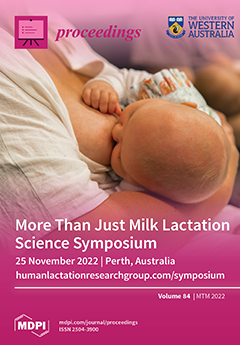Mastitis is an inflammatory breast condition that encompasses a range of clinical presentations, better known as the mastitis spectrum; however, it is poorly understood. Mastitis is believed to be caused by an infection of the breast by bacterial pathogens, with
Staphylococcus aureus being
[...] Read more.
Mastitis is an inflammatory breast condition that encompasses a range of clinical presentations, better known as the mastitis spectrum; however, it is poorly understood. Mastitis is believed to be caused by an infection of the breast by bacterial pathogens, with
Staphylococcus aureus being the most commonly reported causative agent. Gaining a better understanding of the association between the presence of
S. aureus in human milk and the mastitis spectrum is crucial for improving our understanding of the aetiology of mastitis. This study aims to investigate the association between the presence of
S. aureus in human milk and the development of mastitis across the mastitis spectrum. Lactating mothers were recruited and asked to complete a questionnaire relating to their breastfeeding history and breast health. A milk sample was aseptically collected from each breast and cultured to isolate
S. aureus. Preliminary findings show that 27% of lactating mothers with no breast inflammation (12/44) have
S. aureus present in their milk, compared to 38% of mothers (8/21) reporting some form of mastitis-associated breast inflammation. Of the 21 mothers that reported breast inflammation, 12 mothers were diagnosed with mastitis and 9 mothers reported blocked ducts, of whom 58% and 0% had milk samples positive for
S. aureus, respectively. These findings indicate that the development of mastitis may be more complex than the presence of
S. aureus in human milk and further studies are needed to determine the role and pathogenesis of
S. aureus across the mastitis spectrum.
Full article



